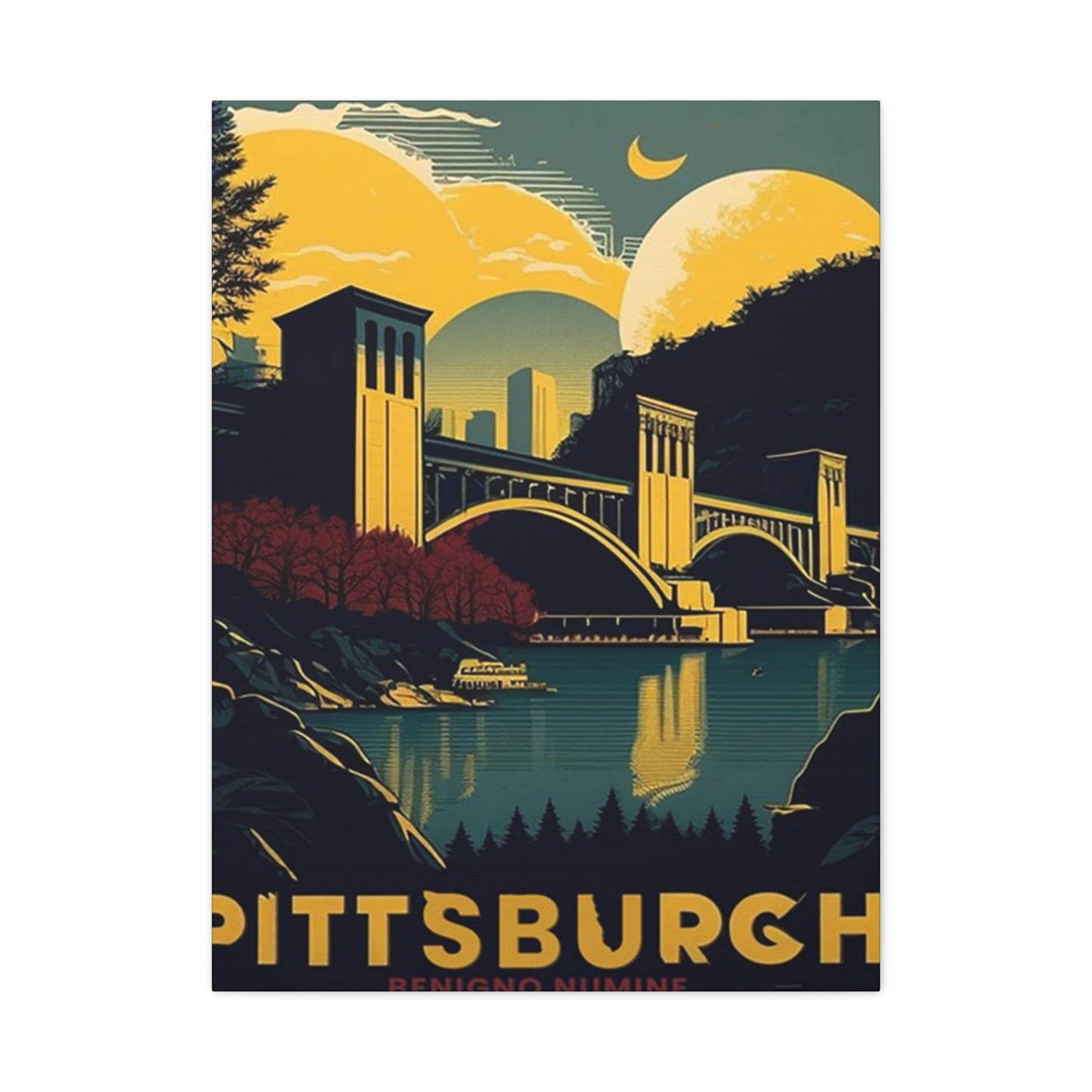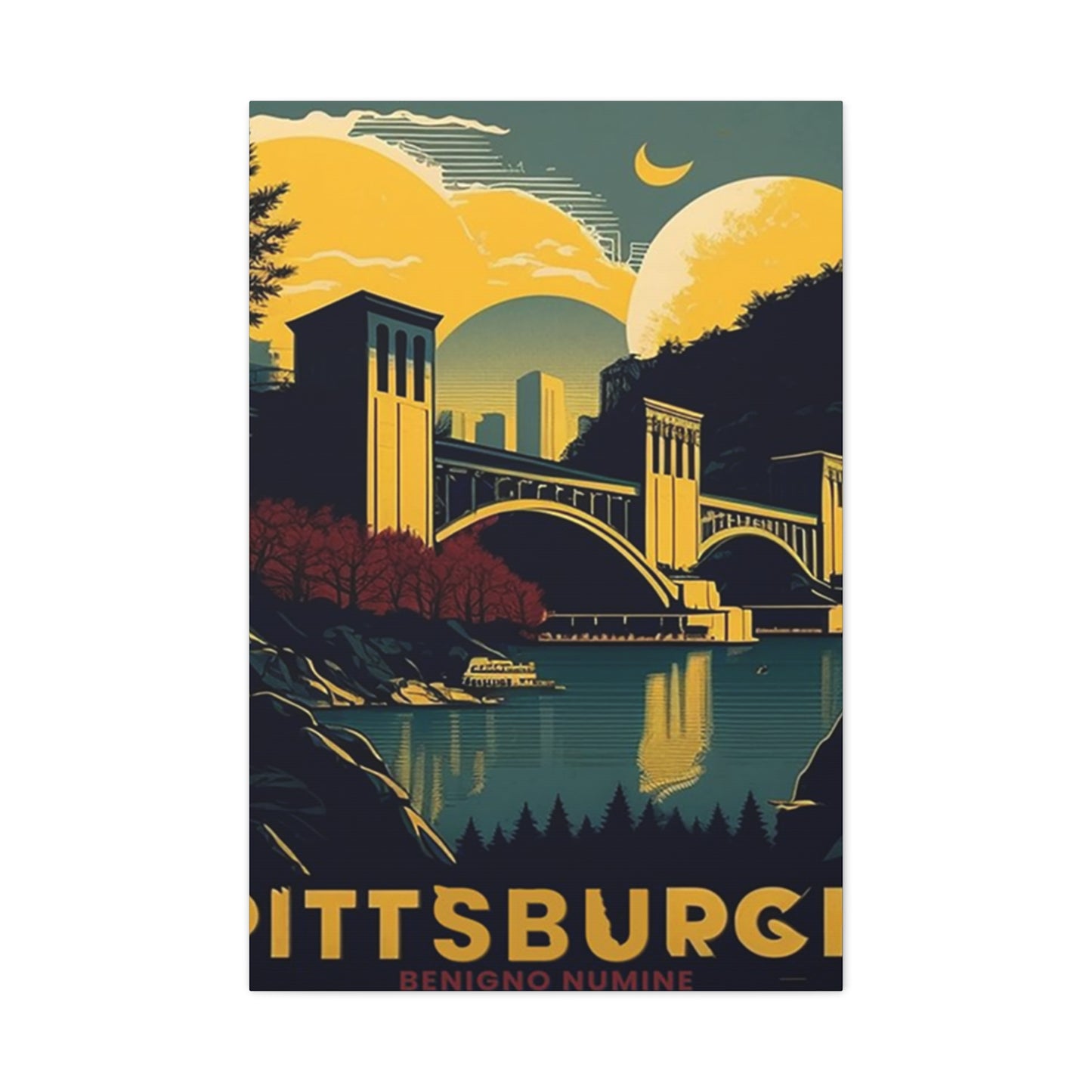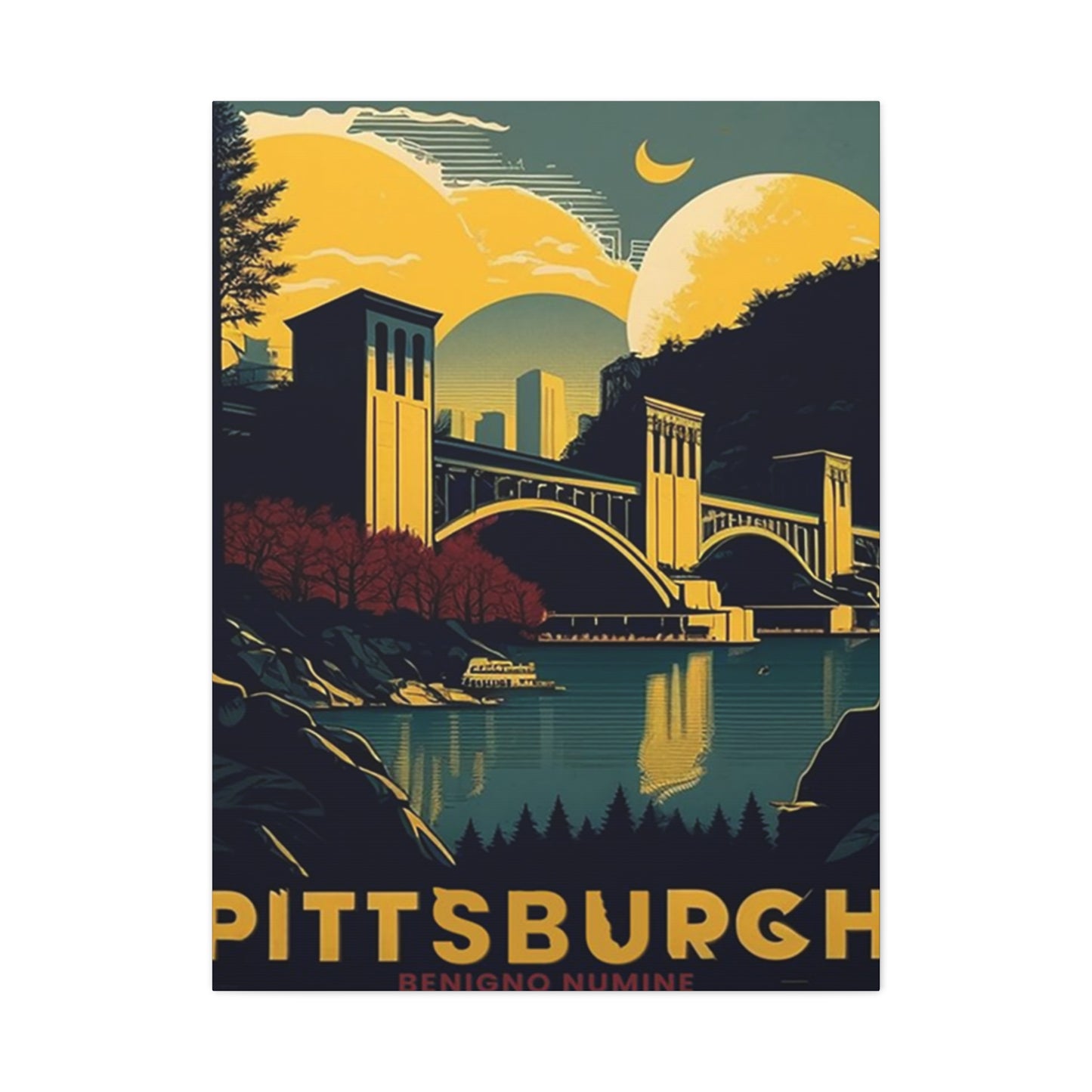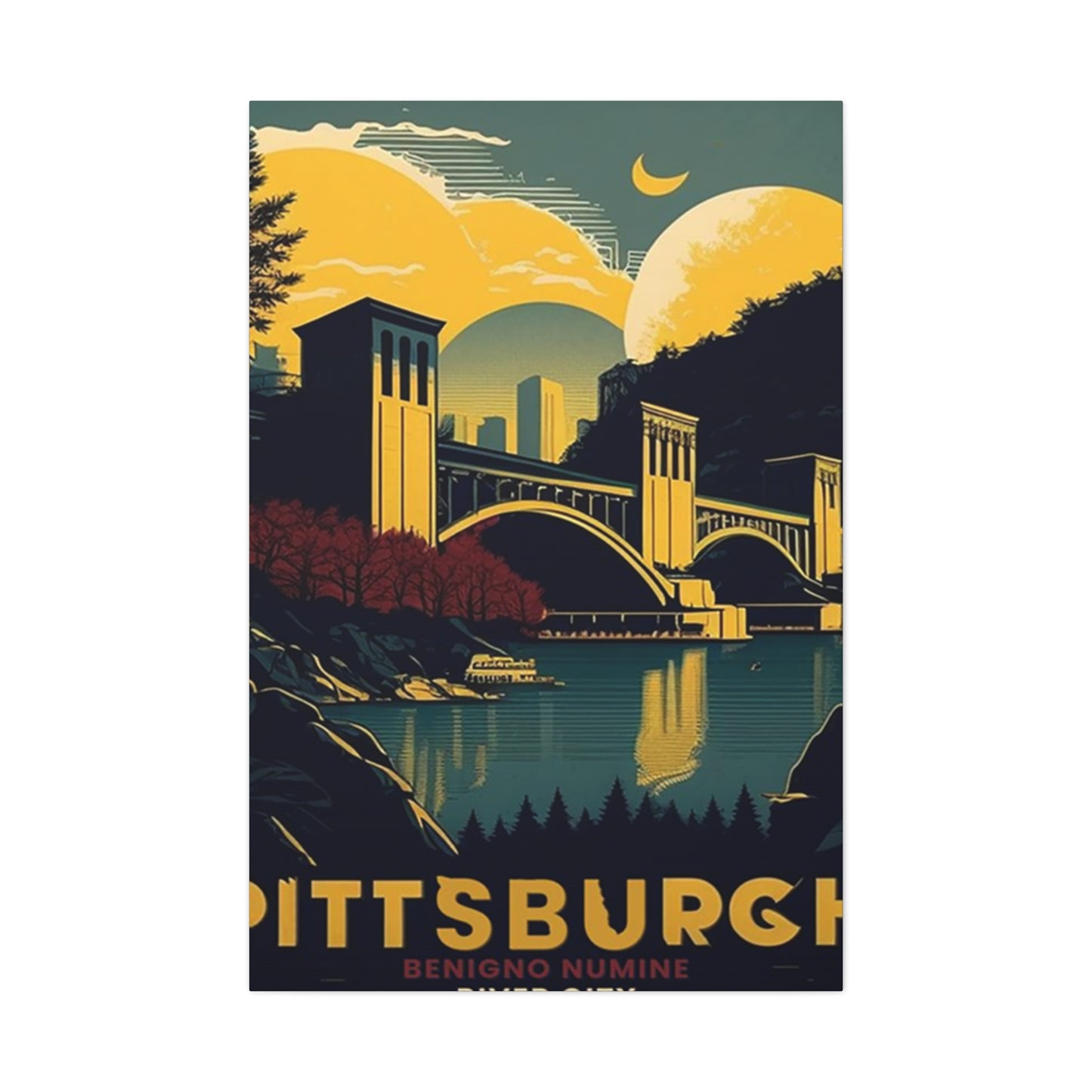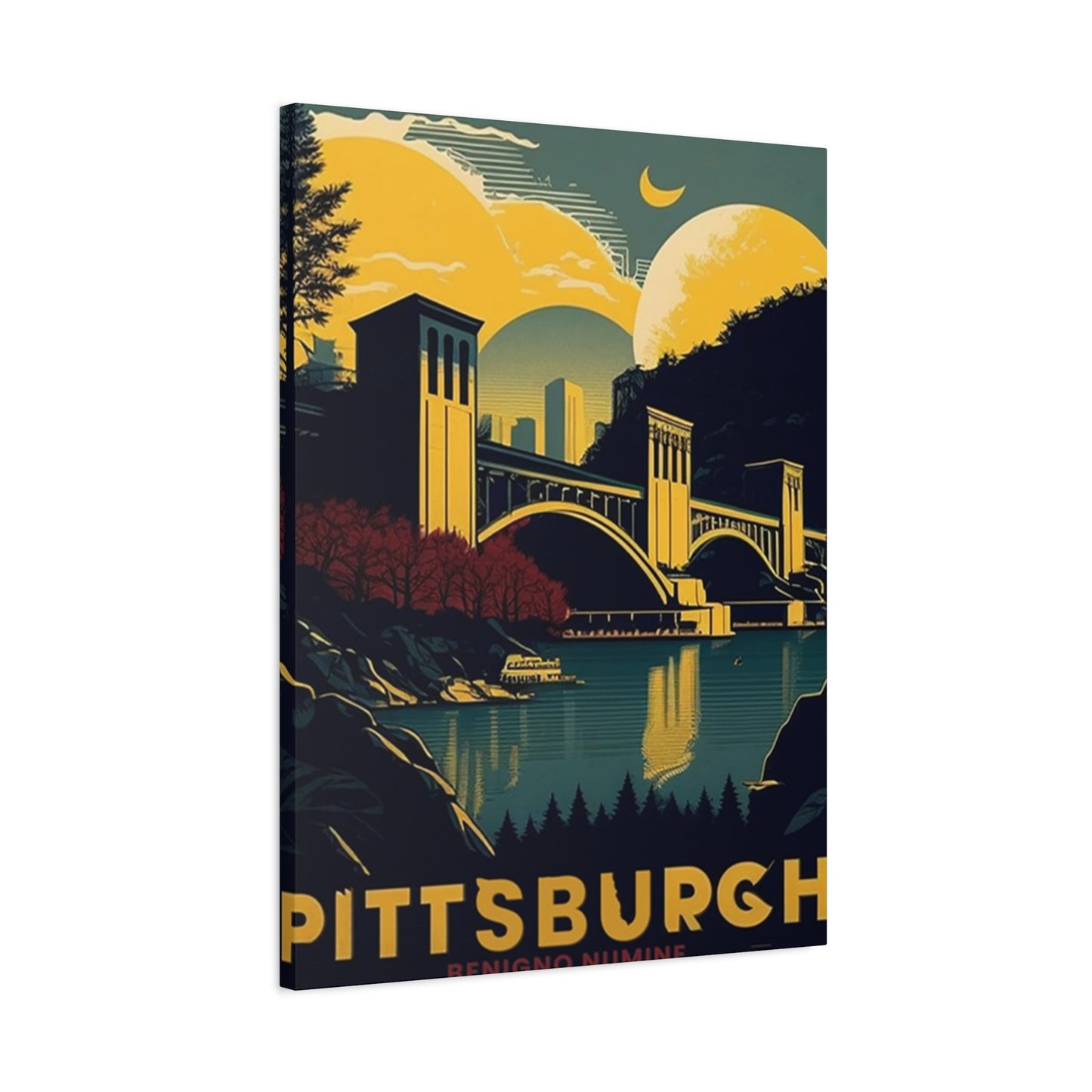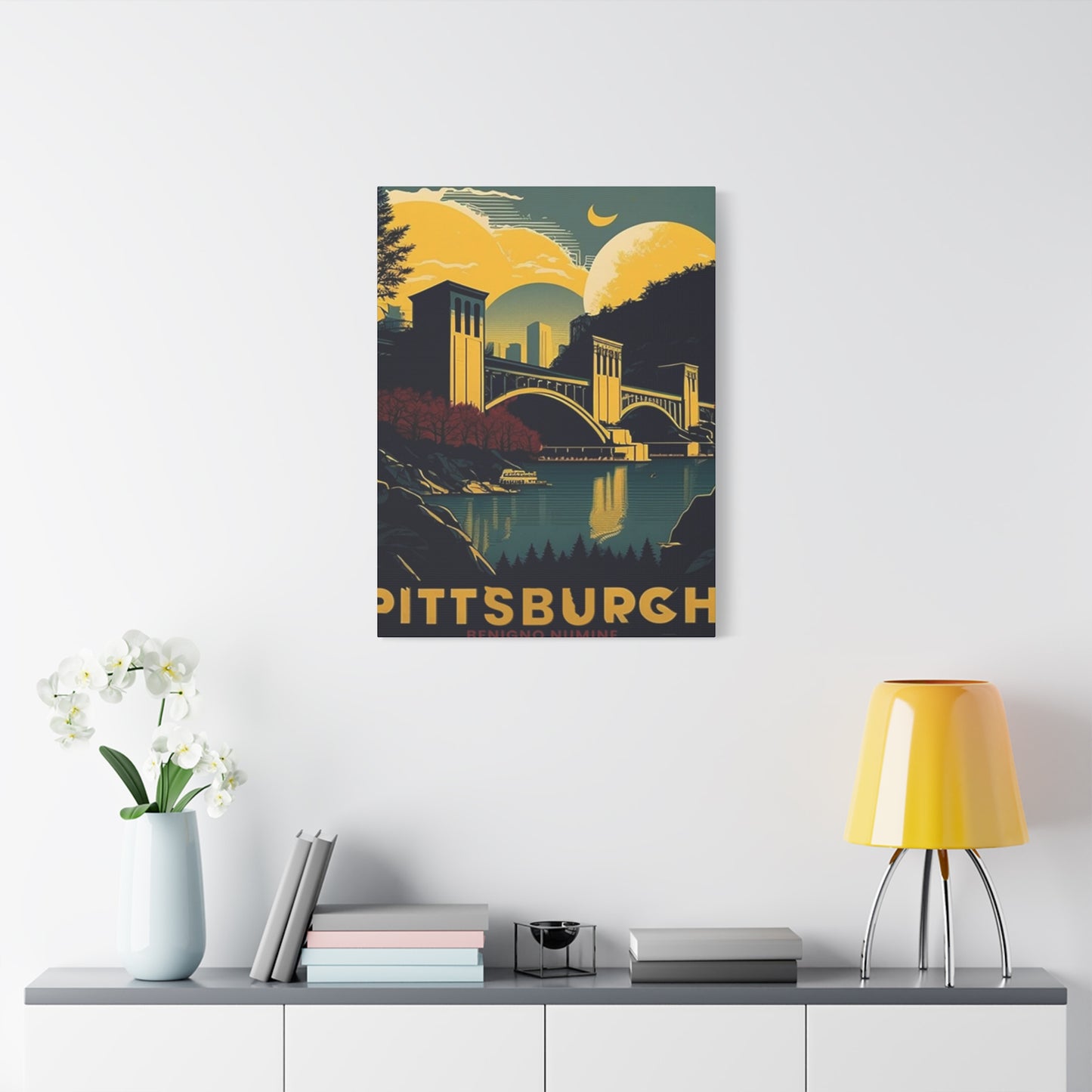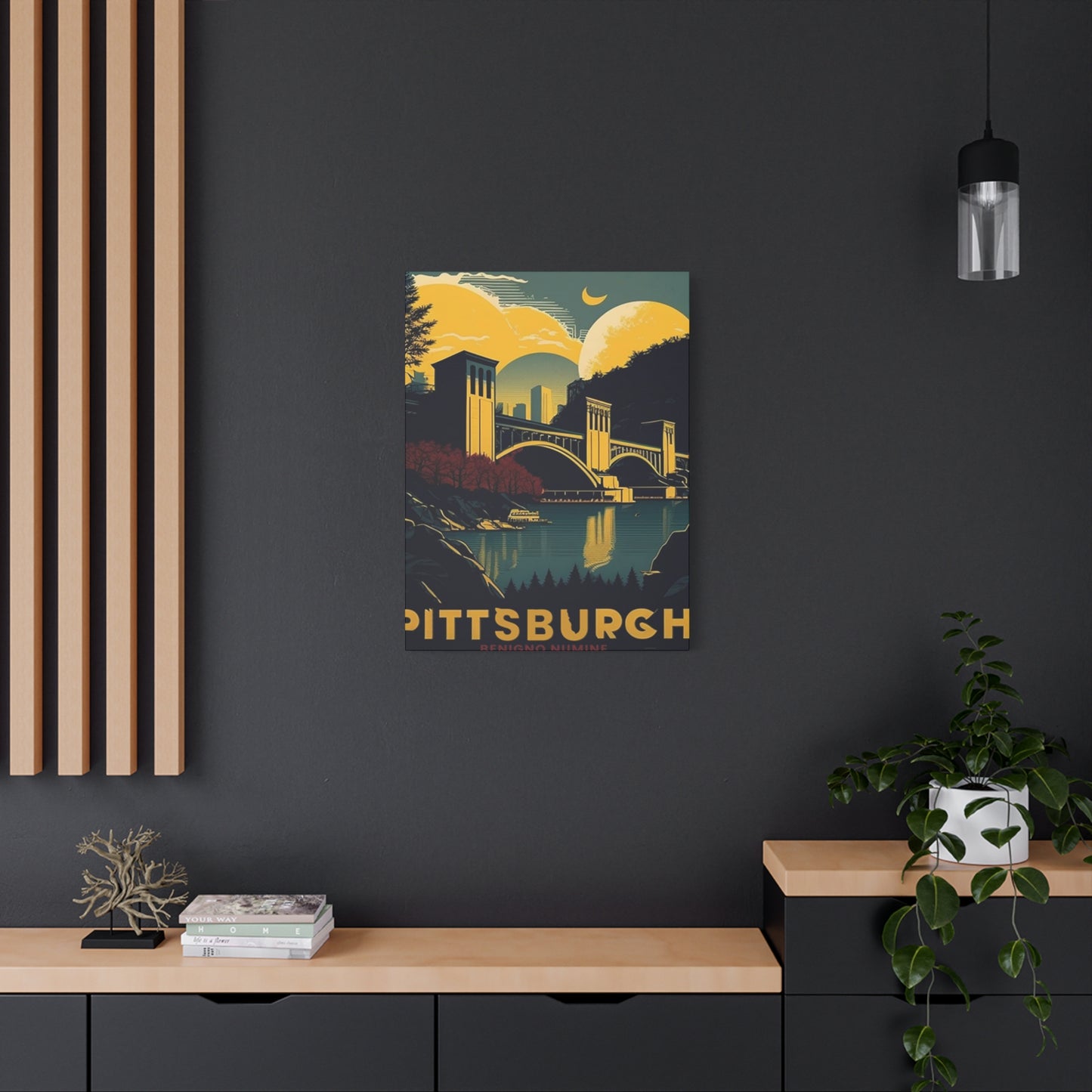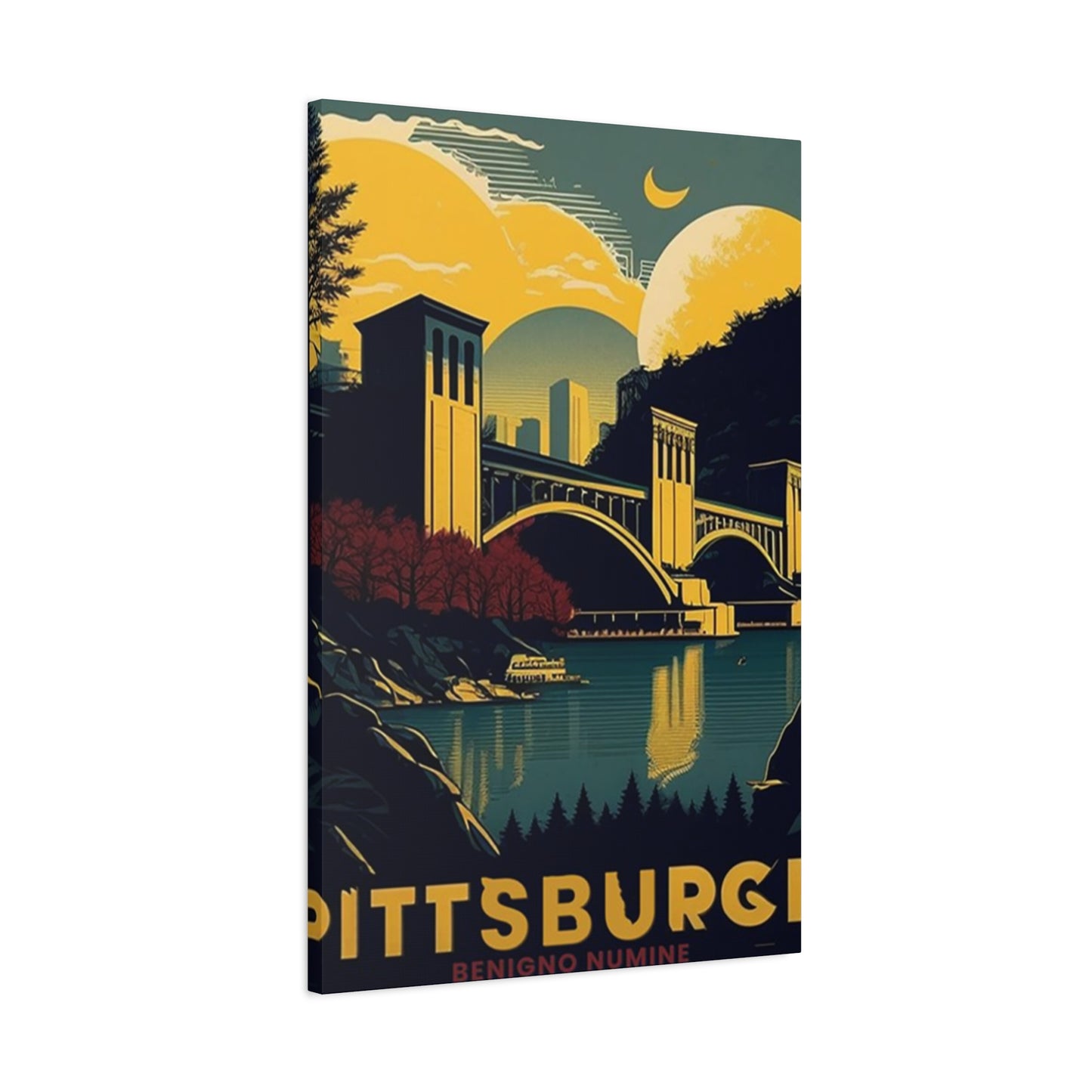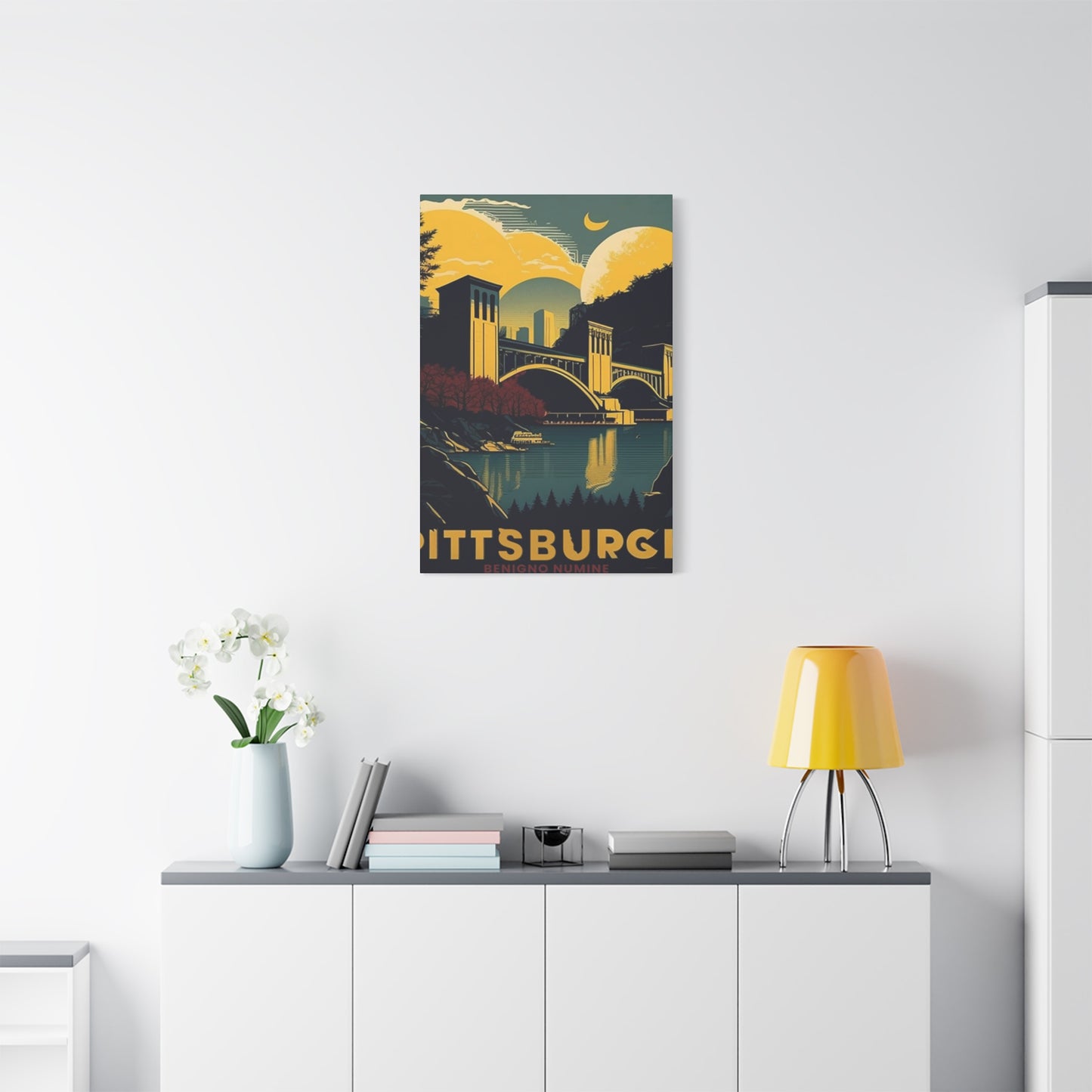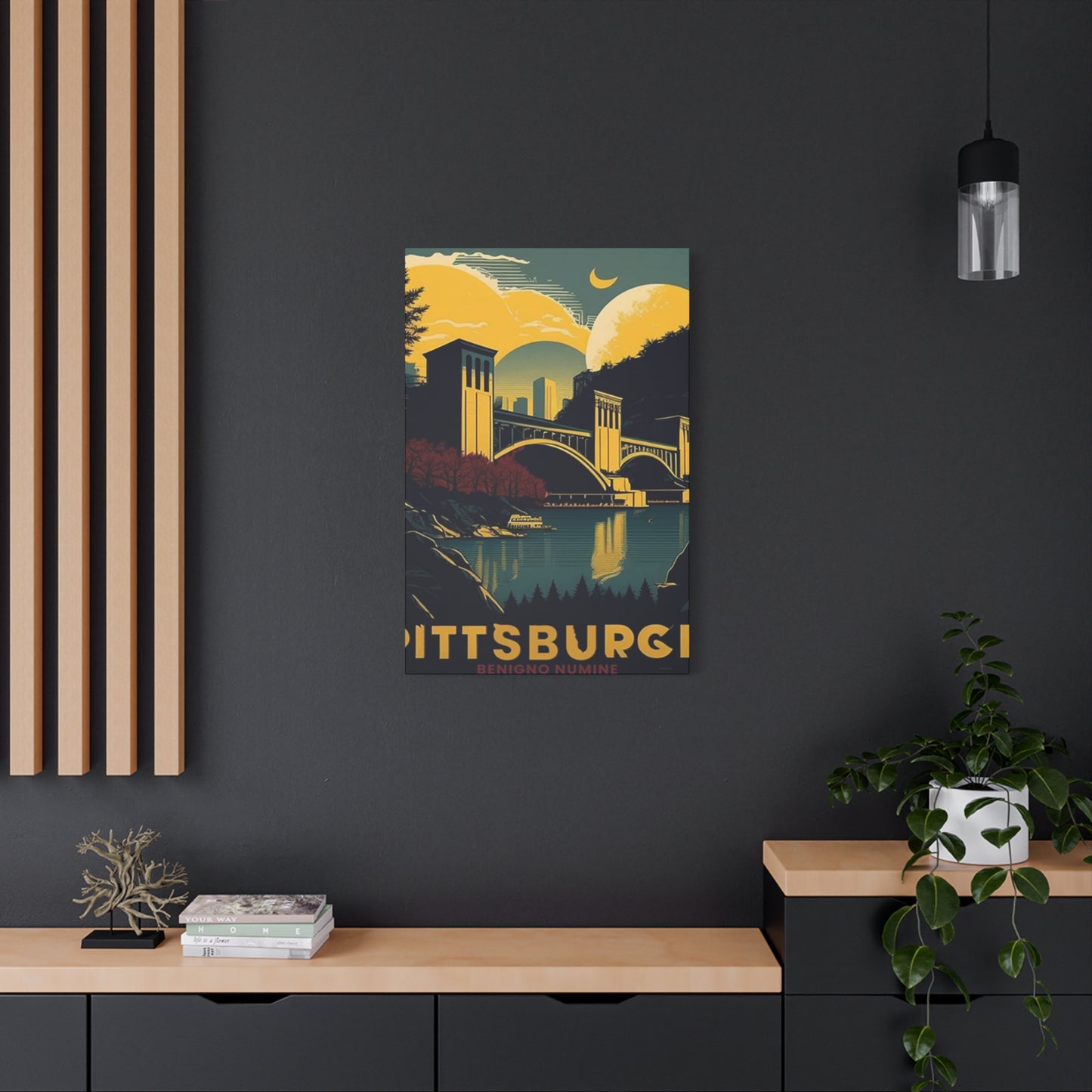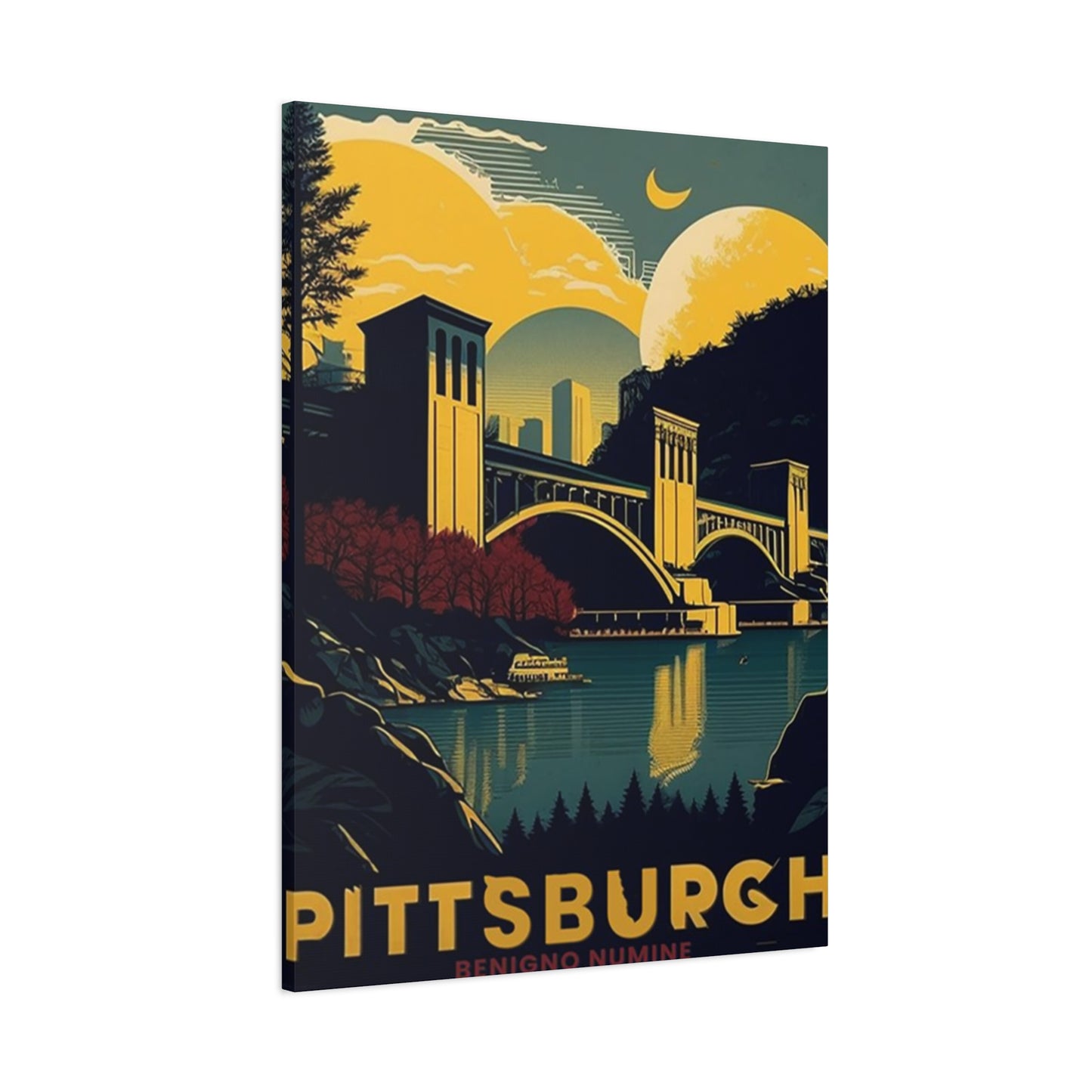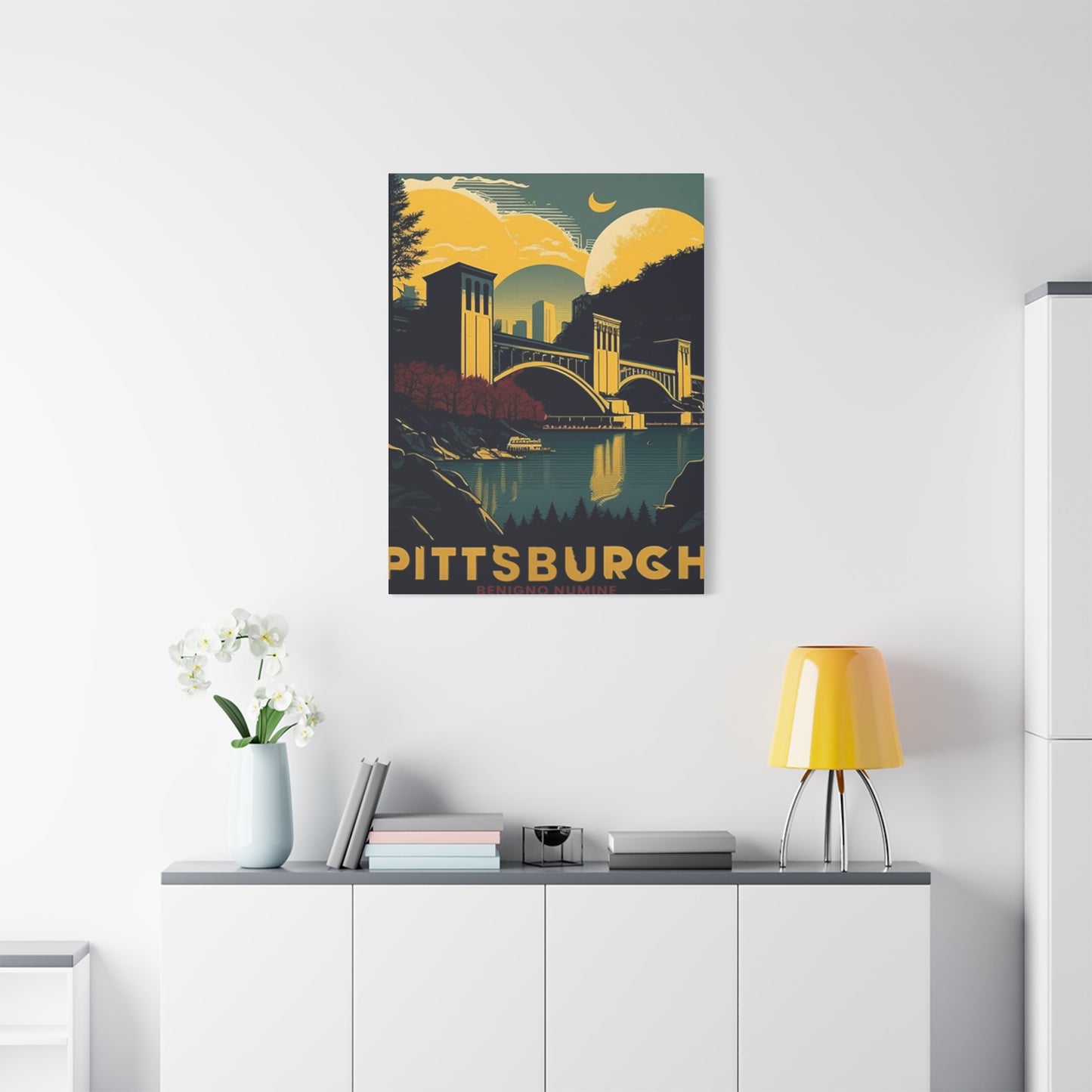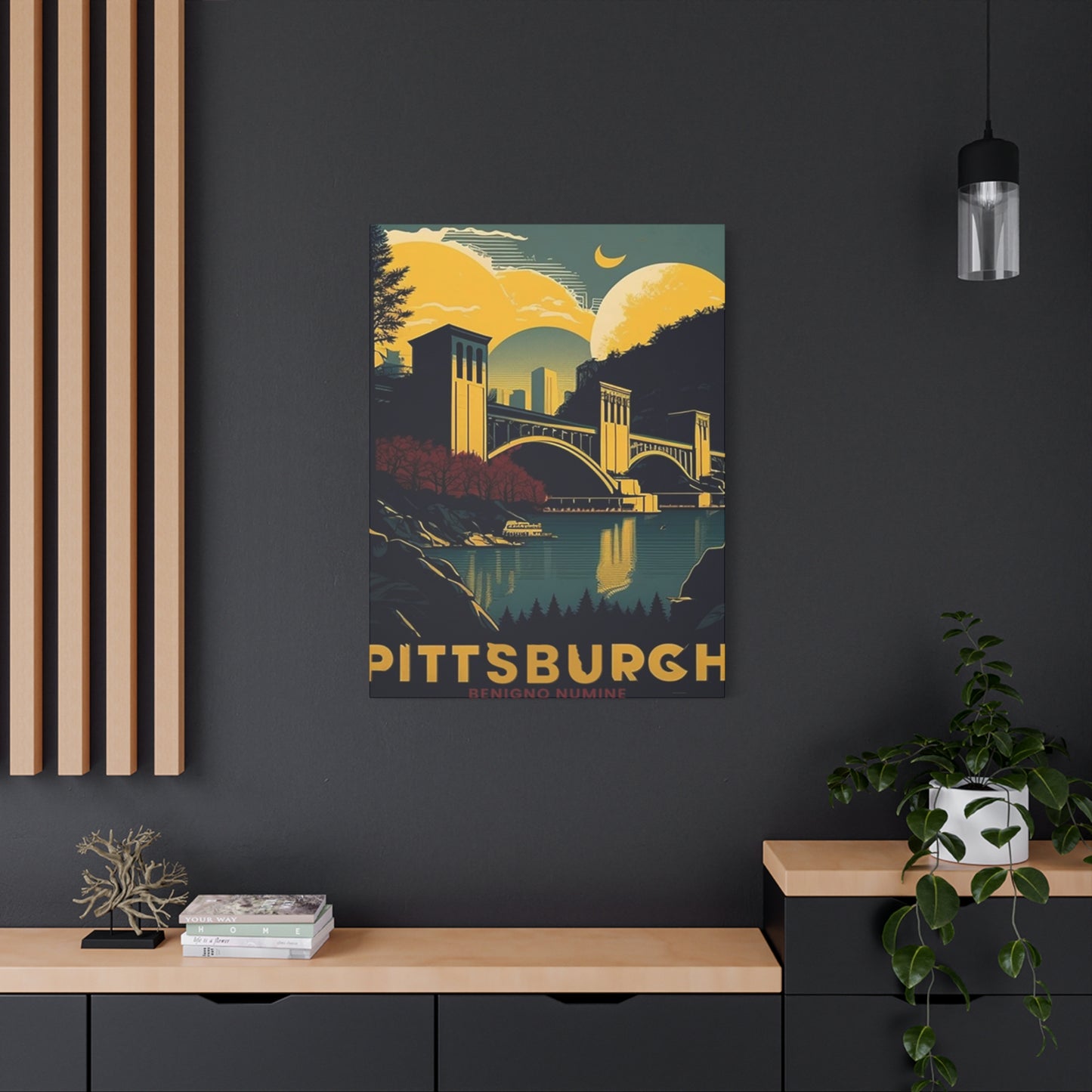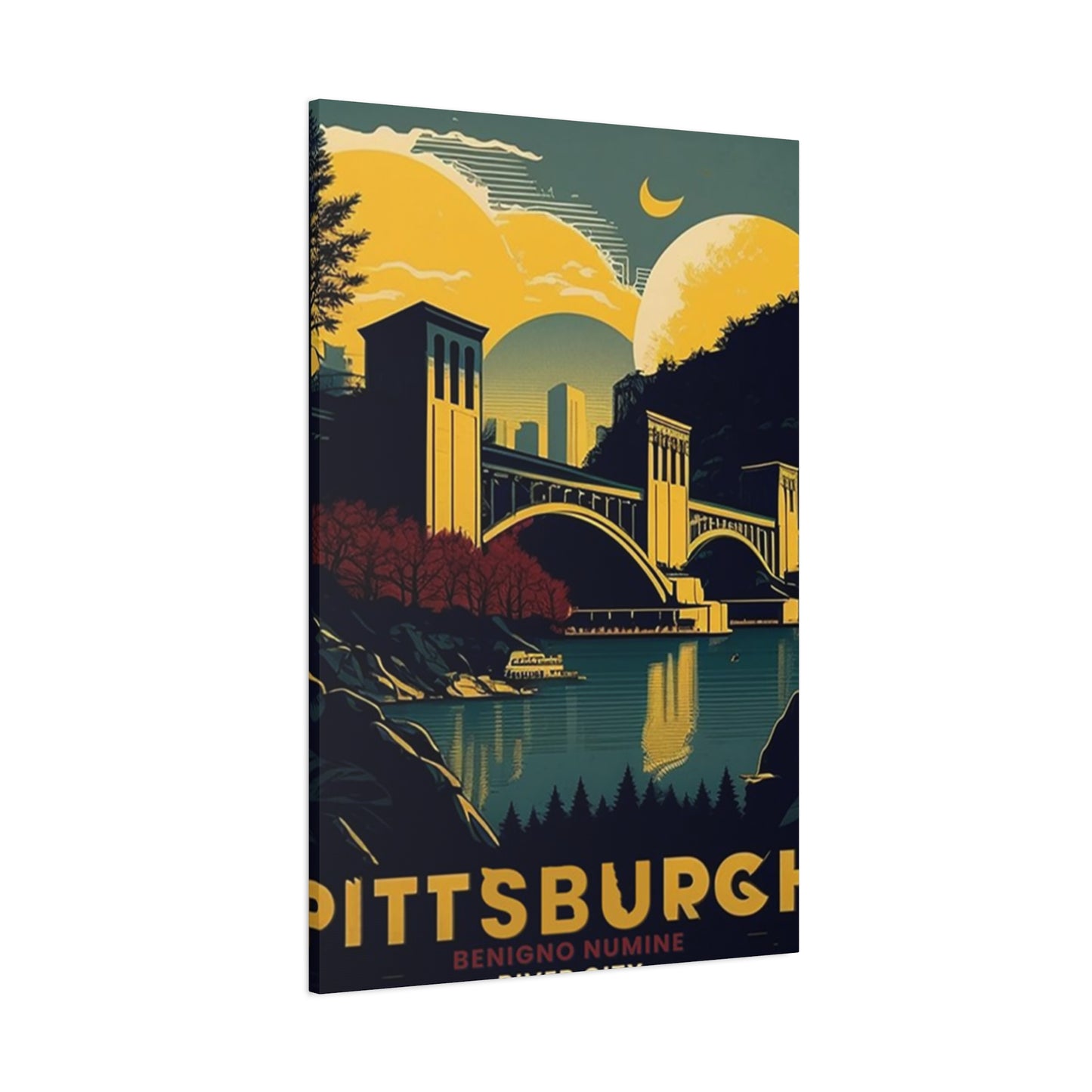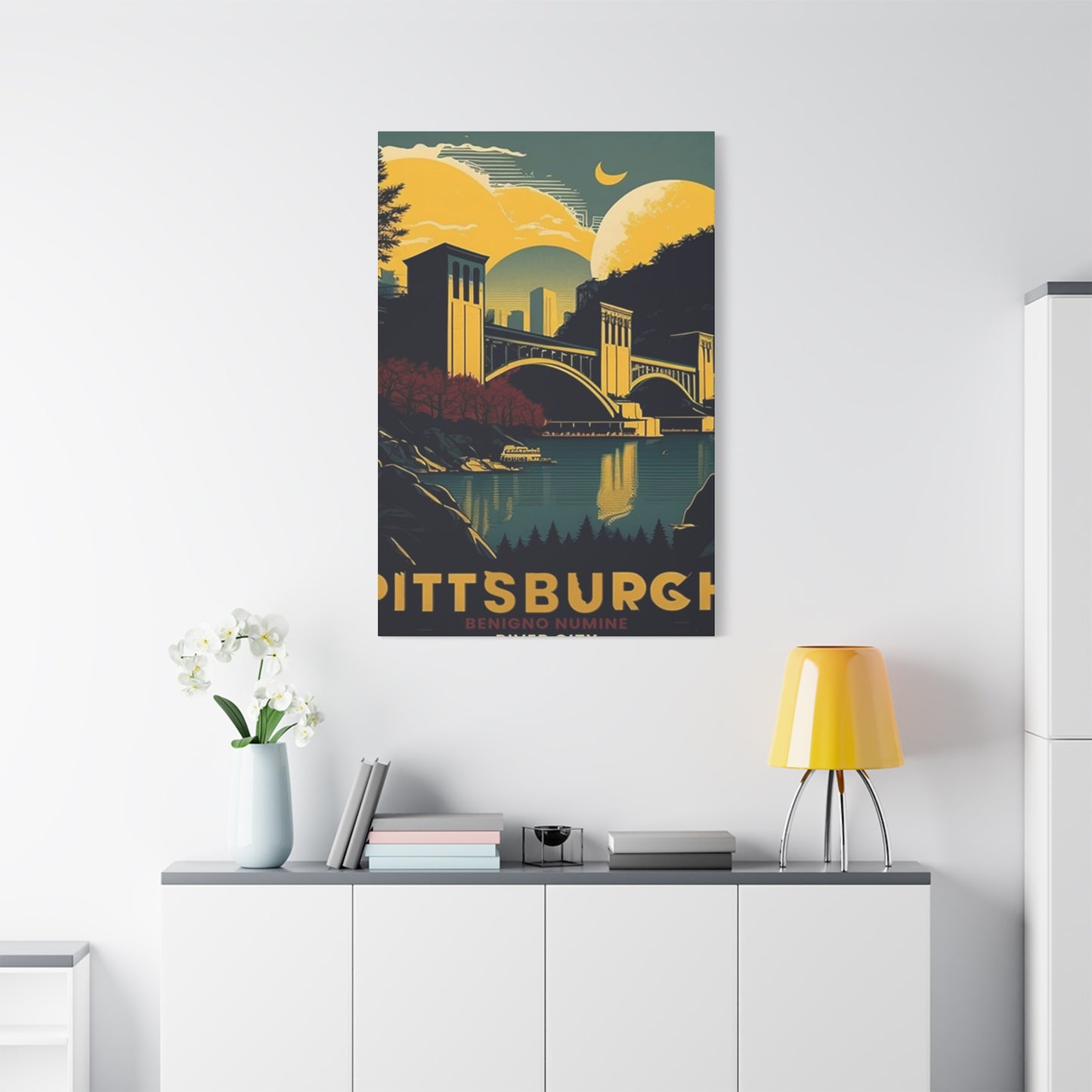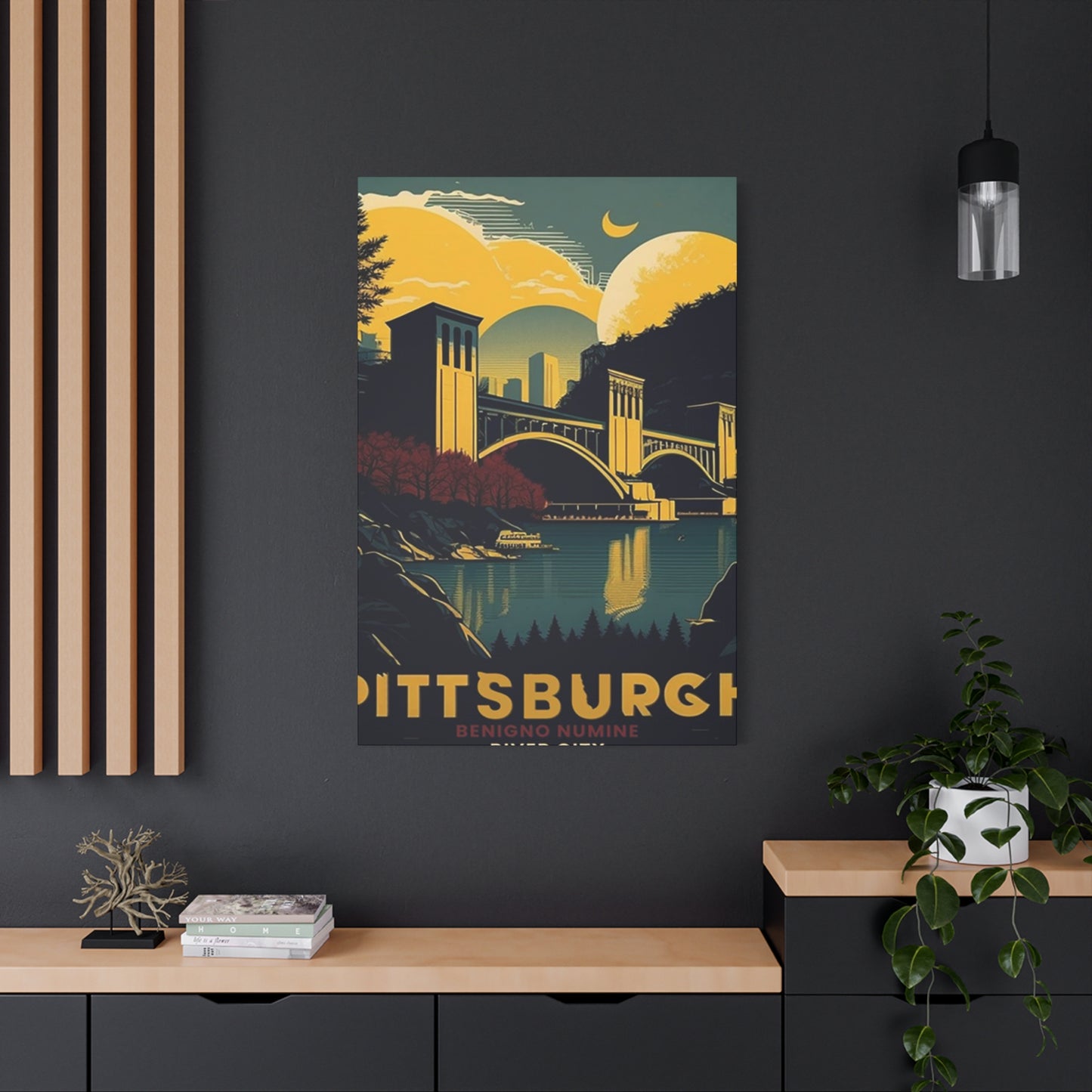Bedroom Aesthetic: Creating a Dreamy night sky Space with Starry Pittsburgh Wall Art
The city of Pittsburgh transforms into a mesmerizing spectacle when darkness falls, revealing a stunning blend of architectural brilliance and natural celestial wonders. This unique combination has inspired countless artists and photographers to capture its essence through various mediums, particularly through poster designs and canvas prints that showcase the magnificent evening atmosphere. The Steel City's transformation from an industrial powerhouse to a cultural hub has made its nocturnal views increasingly popular among art enthusiasts and interior designers who seek to bring a piece of this iconic American landscape into their living spaces.
When examining the artistic representations of Pittsburgh's evening scenery, one cannot help but notice the intricate interplay between urban development and the natural canvas above. The city's distinctive topography, characterized by its position at the confluence of three rivers, creates unique vantage points that allow for breathtaking compositions. Artists who specialize in creating wall art featuring Pittsburgh's nocturnal beauty often spend considerable time scouting locations, studying light patterns, and understanding how the celestial dome interacts with the city's illuminated structures.
The appeal of such artwork extends far beyond simple decoration. These pieces serve as windows to moments frozen in time, capturing the ethereal quality of twilight hours when the city lights begin to twinkle and the heavens reveal their mysterious depths. For residents and visitors alike, these artistic interpretations evoke powerful emotional connections, reminding them of cherished memories or inspiring dreams of future adventures in this remarkable metropolitan area.
Evolution of Pittsburgh's Artistic Identity in Evening Photography
Pittsburgh's journey as a subject of artistic fascination has deep historical roots that trace back to its industrial heritage. During the late nineteenth and early twentieth centuries, the city was primarily known for its steel mills and factories, which created a dramatically different aesthetic than what we observe today. The transformation of Pittsburgh from a smoke-filled industrial center to a clean, modern metropolis has provided artists with rich material for exploration and creative expression.
The shift in Pittsburgh's identity began in earnest during the latter half of the twentieth century when environmental initiatives and economic diversification changed the city's physical appearance. As the steel industry declined and new sectors emerged, the clearing skies revealed architectural gems that had long been obscured by industrial haze. This transformation coincided with advances in photography and printing technology, enabling artists to capture and reproduce the city's beauty with unprecedented clarity and vibrancy.
Early artistic representations of Pittsburgh focused primarily on its industrial might, with paintings and photographs emphasizing the dramatic interplay of fire, smoke, and steel. However, as the city evolved, so did its artistic narrative. Contemporary artists now celebrate Pittsburgh's renaissance, highlighting its modern skyline, historic neighborhoods, and the remarkable clarity of its evening atmosphere. This evolution has made Pittsburgh an increasingly popular subject for wall art, with collectors seeking pieces that reflect both the city's storied past and its promising future.
The development of various artistic techniques has allowed creators to experiment with different styles and approaches when depicting Pittsburgh's nocturnal landscape. From realistic photography that captures every detail with precision to abstract interpretations that emphasize mood and emotion, the range of available artwork reflects the diverse perspectives artists bring to their craft. This variety ensures that anyone seeking to decorate their space with Pittsburgh-themed art can find pieces that resonate with their personal aesthetic preferences.
Architectural Landmarks That Define Pittsburgh's Evening Silhouette
Pittsburgh's distinctive architectural profile plays a crucial role in creating the captivating compositions found in popular wall art and canvas prints. The city boasts an impressive collection of structures that range from historic churches and bridges to modern skyscrapers that pierce the evening atmosphere. Understanding these landmarks provides insight into why Pittsburgh's nocturnal views have become such sought-after subjects for artistic interpretation.
The downtown area, commonly referred to as the Golden Triangle, presents a concentrated collection of architectural achievements that create a dramatic focal point in many artistic compositions. These structures, when illuminated against the darkening heavens, create a striking contrast that photographers and artists find irresistible. The varying heights and styles of these buildings contribute to a dynamic visual rhythm that guides the viewer's eye across the composition, creating engaging and balanced artwork.
Beyond the central business district, Pittsburgh's numerous neighborhoods each contribute their own character to the city's overall aesthetic. Historic areas feature architectural styles from different eras, including Victorian, Art Deco, and mid-century modern designs. These diverse architectural elements provide artists with endless possibilities for creating unique compositions that highlight different aspects of Pittsburgh's built environment.
The bridges of Pittsburgh deserve special mention as they serve as both functional infrastructure and iconic visual elements in evening artwork. The city's numerous river crossings, each with its distinctive design, add layers of visual interest to compositions. When these structures are illuminated at night, they create linear elements that lead the viewer's eye through the composition while simultaneously connecting different parts of the cityscape. Artists often use these bridges as compositional anchors, balancing the vertical elements of buildings with the horizontal spans crossing the rivers.
Churches and religious structures scattered throughout Pittsburgh add another dimension to evening artistic representations. Many of these buildings feature distinctive spires and towers that break the horizon line in interesting ways, creating varied silhouettes against the twilight backdrop. The architectural details of these structures, often highlighted by careful lighting, provide artists with opportunities to incorporate historical and cultural elements into their work.
Aspects of Creating Pittsburgh Evening Canvas Prints
The process of creating high-quality canvas prints featuring Pittsburgh's nocturnal scenery involves numerous technical considerations that significantly impact the final product. Understanding these elements helps both artists and consumers appreciate the complexity involved in producing stunning wall art that accurately captures the city's evening beauty. From initial image capture to final printing, each step requires careful attention to detail and expertise.
Photography forms the foundation of most Pittsburgh evening canvas prints, and capturing quality images requires specialized equipment and techniques. Long exposure photography is often employed to gather sufficient light in low-light conditions while creating dramatic effects with moving elements such as clouds or traffic. Photographers must carefully balance exposure settings to prevent overexposing bright city lights while maintaining detail in darker areas of the composition. This technical challenge requires both experience and artistic vision to execute successfully.
Post-processing plays a crucial role in enhancing raw photographs and preparing them for print reproduction. Digital editing allows artists to adjust color balance, contrast, and saturation to create images that accurately reflect the mood and atmosphere they experienced during capture. Some artists prefer realistic approaches that stay true to what the human eye perceives, while others embrace more stylized interpretations that emphasize certain colors or dramatic elements. The editing process requires both technical skill and artistic judgment to produce images that translate effectively to canvas.
The selection of canvas material significantly impacts the appearance and longevity of the final print. High-quality canvas typically consists of cotton or polyester blends that provide an appropriate texture for artistic reproduction. The weave pattern of the canvas contributes to the overall aesthetic, with finer weaves suited to detailed photographic reproductions and coarser weaves lending themselves to more painterly effects. The canvas must be properly prepared with coatings that ensure even ink absorption and prevent deterioration over time.
Printing technology has advanced considerably in recent years, enabling the production of canvas prints with remarkable color accuracy and detail resolution. Modern giclée printing processes use archival-quality inks that resist fading and maintain their vibrancy for decades when properly displayed. The printer's color management system must be carefully calibrated to ensure that the colors in the final print match the artist's digital file. This calibration process requires regular maintenance and adjustment to maintain consistency across multiple prints.
The stretching and mounting process represents the final stage in creating a finished canvas print ready for display. The printed canvas must be carefully stretched over a wooden frame, ensuring proper tension that prevents sagging while avoiding excessive stress that could damage the material. The edges of the canvas are typically wrapped around the frame sides, creating a finished appearance that eliminates the need for traditional framing. Some artists prefer gallery-wrapped edges where the image continues around the sides, while others opt for mirrored or solid color edges.
Pittsburgh Evening Artwork Compositions
The application of color theory principles significantly influences the emotional impact and visual effectiveness of Pittsburgh evening artwork. Understanding how different colors interact and affect viewer perception helps explain why certain compositions resonate more powerfully than others. Artists who create Pittsburgh-themed wall art must navigate complex color relationships to produce pieces that capture the city's unique atmospheric qualities.
The evening hours in Pittsburgh present a rich palette of colors that shift dramatically as natural light fades and artificial illumination becomes dominant. During the golden hour just after sunset, warm orange and pink tones often fill the western horizon, gradually transitioning to deeper purples and blues as full darkness approaches. These natural color gradients provide artists with opportunities to create compositions with strong atmospheric perspective, where color shifts help establish depth and spatial relationships within the image.
The interplay between warm and cool colors creates much of the visual drama in Pittsburgh evening artwork. The warm golden tones of streetlights and building illumination contrast beautifully with the cooler blues and purples of the twilight atmosphere. This color contrast naturally draws viewer attention and creates a sense of vibrancy and energy that reflects the city's dynamic character. Artists often emphasize these contrasts through careful exposure and editing choices that enhance the natural color relationships present in the scene.
Complementary color relationships play an important role in creating visually harmonious compositions. The blue-orange complementary pair frequently appears in Pittsburgh evening artwork, with the blue tones of the evening atmosphere balanced by the warm orange glow of urban lighting. This complementary relationship creates visual balance while maintaining visual interest and preventing monotony. Artists may subtly adjust these color relationships during post-processing to strengthen the composition's overall coherence.
Saturation levels must be carefully managed to create realistic yet visually engaging artwork. Oversaturated colors can appear artificial and garish, undermining the artwork's credibility and emotional impact. Conversely, undersaturated images may appear dull and fail to capture the vibrancy of Pittsburgh's illuminated evening landscape. Skilled artists find the optimal saturation balance that enhances the image's visual appeal while maintaining a connection to the actual experience of viewing the city at night.
The psychological associations of different colors influence how viewers respond emotionally to Pittsburgh evening artwork. Blue tones often evoke feelings of calm, tranquility, and introspection, while warmer colors suggest energy, warmth, and vitality. By controlling the balance between these color temperatures, artists can guide the emotional tone of their work, creating pieces that range from peaceful and contemplative to energetic and exciting. This emotional dimension adds depth to the artwork, transforming it from mere decoration into a meaningful artistic statement.
Popular Viewing Locations for Pittsburgh Evening Photography
Pittsburgh's unique topography creates numerous exceptional vantage points that have become favorite locations for photographers and artists seeking to capture the city's evening beauty. Understanding these locations provides insight into the compositions frequently featured in popular wall art and canvas prints. Each location offers distinct perspectives and compositional opportunities that contribute to the diversity of available Pittsburgh-themed artwork.
Mount Washington represents perhaps the most iconic viewpoint for capturing Pittsburgh's evening panorama. The observation decks along Grandview Avenue provide elevated perspectives that encompass the entire downtown area, the confluence of the three rivers, and the surrounding hillsides. This elevated position allows photographers to include both the illuminated cityscape and the expansive atmosphere above, creating compositions that showcase the relationship between urban development and natural surroundings. The accessibility of this location has made it a favorite among both professional artists and casual photographers.
The North Shore area offers ground-level perspectives that emphasize the verticality of downtown buildings and the architectural details of the city's structures. Positions along the riverfront parks provide opportunities to incorporate the reflective surfaces of the rivers into compositions, adding another dimension of visual interest. The proximity to major landmarks allows photographers to create images that focus on specific architectural elements while maintaining the context of the broader urban environment.
Point State Park, situated at the confluence of Pittsburgh's three rivers, provides unique compositional opportunities that highlight the city's geographic setting. The fountain at the park's tip serves as a natural focal point that can anchor compositions while the surrounding views encompass multiple directions. Evening photographs from this location can capture the transition from natural to artificial light, documenting how the city transforms as darkness falls.
The Hot Metal Bridge and its surrounding areas offer perspectives that incorporate industrial heritage elements with modern development. The bridge itself provides an interesting foreground element that adds depth and context to compositions featuring downtown Pittsburgh. The South Side riverfront locations accessible from this area allow photographers to experiment with different angles and compositions that showcase lesser-known aspects of Pittsburgh's evening character.
Schenley Park and the surrounding Oakland neighborhood provide opportunities to capture Pittsburgh's evening scenery from elevated positions that offer different perspectives than the more famous Mount Washington viewpoints. These locations allow artists to include elements of the city's extensive park system and academic institutions, creating compositions that reflect Pittsburgh's identity as both an urban center and a city with significant green spaces.
Variations in Pittsburgh's Nocturnal Atmosphere
The changing seasons dramatically affect the appearance of Pittsburgh's evening atmosphere, creating diverse opportunities for artistic expression throughout the year. Understanding these seasonal variations helps explain the range of moods and aesthetics found in Pittsburgh-themed wall art and canvas prints. Each season presents unique lighting conditions, weather patterns, and atmospheric qualities that influence both the creation and selection of artwork.
Winter evenings in Pittsburgh arrive early, with darkness falling by late afternoon during the shortest days of the year. The cold air during this season often creates exceptionally clear atmospheric conditions that allow for sharp, detailed views of celestial features. Winter compositions frequently emphasize the contrast between the warm glow of urban lighting and the crisp, cold quality of the winter atmosphere. Snow-covered surfaces reflect city lights, creating additional illumination that adds dimension to evening scenes. Artists often capture the cozy, intimate feeling of the city during winter evenings, emphasizing how the warm light spilling from windows and streetlights creates islands of comfort against the cold darkness.
Spring brings longer evenings and the gradual greening of Pittsburgh's extensive tree canopy. The transitional quality of spring creates opportunities for capturing dramatic cloud formations and variable lighting conditions. Artists working during this season often emphasize the renewal and energy associated with spring, using vibrant color palettes that reflect the season's character. The increasing daylight extends the golden hour period, providing more time for photographers to capture optimal lighting conditions. Spring storms can create dramatic atmospheric effects that add visual interest and emotional intensity to evening compositions.
Summer evenings in Pittsburgh extend well into the night, with twilight lingering for extended periods. The warm, humid air characteristic of Pittsburgh summers can create atmospheric haze that softens distant elements and creates subtle gradations of tone and color. This atmospheric quality lends itself to romantic, dreamy interpretations of the cityscape. Summer compositions often feature vibrant sunsets with rich warm tones that gradually transition to deep blues as full darkness arrives. The seasonal foliage reaches its peak density during summer, creating lush green foreground elements that frame urban views.
Autumn presents perhaps the most dramatic seasonal transformation in Pittsburgh's appearance. The changing leaves create spectacular foreground elements in warm reds, oranges, and yellows that complement the evening light beautifully. The crisp air of autumn creates clear atmospheric conditions similar to winter but with the added visual interest of seasonal color. Artists often emphasize the cozy, contemplative mood associated with autumn evenings, capturing the sense of transition and reflection that characterizes this season. The earlier arrival of darkness during autumn provides opportunities to capture the city during the blue hour when the atmosphere retains color while city lights become dominant.
Interior Design Considerations for Pittsburgh Evening Wall Art
Incorporating Pittsburgh evening wall art into interior spaces requires thoughtful consideration of various design elements to ensure the artwork enhances rather than overwhelms the room. Understanding these principles helps both homeowners and designers make informed decisions about selecting and displaying Pittsburgh-themed canvas prints. The goal is to create harmonious environments where the artwork contributes meaningfully to the overall aesthetic while serving as a focal point or supporting element within the design scheme.
Scale represents one of the most critical considerations when selecting wall art for any space. Large-scale Pittsburgh evening canvas prints can serve as dramatic focal points in spacious rooms with high ceilings, commanding attention and setting the tone for the entire space. In smaller rooms or areas with limited wall space, more modest-sized prints allow the artwork to contribute without overwhelming the environment. The relationship between artwork size and wall dimensions should follow general design principles that maintain visual balance and proportion.
Color coordination between the artwork and the existing interior palette significantly impacts the overall cohesiveness of the space. Pittsburgh evening artwork typically features blues, purples, oranges, and yellows, and these colors should harmonize with the room's existing color scheme. Rooms with neutral color palettes provide maximum flexibility, allowing the artwork's colors to become accent elements that add visual interest. Alternatively, interior color schemes can be built around selected artwork, using the piece as inspiration for coordinating furniture, accessories, and accent colors throughout the space.
The style of the artwork should complement the overall design aesthetic of the interior. Modern, minimalist spaces often benefit from clean, contemporary photographic prints that emphasize geometric patterns and bold compositions. Traditional interiors may call for more painterly interpretations or images that incorporate historical architectural elements. The frame or mounting style should also align with the room's aesthetic, with simple gallery-wrapped canvases suiting contemporary spaces and more elaborate framing appropriate for traditional settings.
Lighting considerations significantly affect how Pittsburgh evening artwork appears in interior spaces. Natural light from windows can create glare on canvas surfaces, potentially diminishing the artwork's visual impact. Strategic placement that minimizes direct sunlight exposure helps prevent fading while ensuring optimal viewing conditions. Artificial lighting can be used to highlight artwork, with directional fixtures creating dramatic presentations that draw attention to the piece. The color temperature of interior lighting affects how the artwork's colors appear, with warm lighting emphasizing orange and yellow tones while cool lighting enhances blues and purples.
The emotional atmosphere desired for the space should inform artwork selection. Pittsburgh evening scenes can evoke various moods depending on composition, color palette, and subject emphasis. Peaceful, contemplative spaces benefit from calm compositions with balanced color schemes and minimal visual complexity. Dynamic, energetic environments might call for dramatic compositions with strong contrasts and bold color relationships. Understanding the intended use and emotional character of the space helps guide appropriate artwork selection.
Canvas Print Quality Indicators and Selection Criteria
Discerning consumers seeking high-quality Pittsburgh evening canvas prints must understand the various quality indicators that distinguish superior products from inferior alternatives. This knowledge empowers buyers to make informed purchasing decisions and ensures they receive artwork that meets their expectations for appearance and longevity. Multiple factors contribute to overall print quality, and evaluating these elements helps identify prints that justify their price points.
Image resolution represents a fundamental quality indicator that determines how much detail the print can reproduce. High-resolution source images contain more information, allowing for larger print sizes without visible pixelation or loss of clarity. Professional Pittsburgh evening photography typically employs high-resolution cameras that capture sufficient detail for large-format printing. Consumers should inquire about the resolution of source images, particularly when ordering large canvas prints, to ensure the final product maintains sharpness and detail throughout.
Color accuracy and consistency distinguish professional-quality prints from inferior reproductions. Quality printing operations employ color management systems that ensure faithful reproduction of the artist's intended colors. The printing process should produce consistent results across multiple prints, with each reproduction matching the established color standards. Variations in color from print to print indicate inadequate quality control and suggest potential issues with other aspects of the production process.
Canvas material quality significantly impacts both the appearance and durability of the finished print. Premium canvas consists of tightly woven natural fibers that provide an appropriate texture for artistic reproduction. The canvas should feel substantial without being excessively stiff, and the weave should be consistent throughout. Quality canvas properly prepared with appropriate coatings that promote even ink absorption and protect against environmental degradation. Lower-quality canvases may exhibit uneven texture, loose weave patterns, or inadequate protective coatings that compromise longevity.
Ink quality determines the print's resistance to fading and color shifting over time. Archival-quality pigment-based inks offer superior longevity compared to dye-based alternatives, maintaining their appearance for decades when properly displayed. Quality prints should come with information about the inks used and their expected lifespan under normal display conditions. Reputable producers often provide certificates of authenticity that document the materials and processes used in creating the print.
Frame construction quality affects both the appearance and durability of gallery-wrapped canvas prints. Solid wood stretcher bars provide superior dimensional stability compared to inferior alternatives constructed from composite materials or thin wood. The frame corners should feature proper joinery that maintains alignment and prevents separation over time. Quality frames include appropriate support structures that prevent the canvas from sagging or developing waves. The thickness of the stretcher bars contributes to the piece's visual presence, with deeper profiles creating more substantial, impressive presentations.
Preservation and Care for Pittsburgh Canvas Art Prints
Proper care and maintenance significantly extend the lifespan of Pittsburgh evening canvas prints while preserving their appearance and value. Understanding appropriate preservation practices helps collectors protect their investments and ensures these artistic pieces continue enhancing their spaces for years to come. Both preventive measures and routine maintenance contribute to optimal preservation outcomes.
Environmental conditions play a crucial role in canvas print preservation. Temperature and humidity fluctuations can cause canvas material to expand and contract, potentially leading to warping, cracking, or separation from the frame. Maintaining relatively stable interior conditions helps prevent these issues. Extreme temperatures should be avoided, as should locations near heating vents, radiators, or air conditioning units that create localized temperature variations. Humidity levels between forty and sixty percent typically provide ideal conditions for canvas preservation.
Light exposure represents one of the most significant threats to canvas print longevity. Both natural sunlight and artificial lighting can cause inks to fade over time, gradually diminishing the artwork's vibrancy and visual impact. Direct sunlight poses the greatest risk, as ultraviolet radiation accelerates degradation. Canvas prints should be positioned away from windows where they would receive direct sun exposure. If placement near windows is unavoidable, UV-filtering window films or protective glazing can reduce harmful radiation exposure. Artificial lighting should be kept at moderate levels, and consideration should be given to using LED bulbs that emit minimal UV radiation.
Dust accumulation on canvas surfaces can dull the artwork's appearance and potentially create abrasion if improperly removed. Regular gentle cleaning prevents significant buildup and maintains optimal appearance. Dust removal should be performed using soft, clean cloths or specialized dusting tools designed for delicate surfaces. The cleaning motion should be gentle and follow the canvas weave direction to avoid disturbing the printed surface. Avoid using household dusting products or sprays that might leave residue or cause chemical reactions with the canvas or inks.
Physical protection from accidental damage requires thoughtful placement and handling practices. Canvas prints should be hung securely using appropriate hardware that can support their weight without risk of falling. High-traffic areas pose risks of accidental contact that could damage the canvas surface. Corners are particularly vulnerable to bumps and impacts that can crush the stretcher frame or tear the canvas. When relocating canvas prints, careful handling prevents scratching, denting, or other damage. The print should be carried by the frame rather than the canvas surface, and protective wrapping should be used during transport or storage.
Periodic inspection allows early detection of potential issues before they become serious problems. Canvas prints should be examined regularly for signs of deterioration such as color fading, canvas sagging, frame separation, or surface damage. Identifying problems early enables timely intervention that may prevent further degradation. Professional restoration services can address significant issues, though preventive care remains the most effective approach to preservation.
Pittsburgh's River System in Evening Compositions
The three rivers that converge in Pittsburgh create distinctive compositional elements that feature prominently in evening wall art and canvas prints. Understanding how these waterways contribute to the city's aesthetic character provides insight into why they appear so frequently in Pittsburgh-themed artwork. The rivers serve multiple compositional functions, adding visual interest while connecting different elements within the frame.
The Allegheny River flows from the northeast, creating a natural boundary that separates downtown Pittsburgh from the North Shore neighborhoods. In evening compositions, this river often appears as a dark ribbon that reflects city lights, creating mirror images of illuminated structures. The width and relatively calm flow of the Allegheny make it an ideal reflective surface that doubles the visual impact of architectural lighting. Photographers often position themselves to capture these reflections, using the water's surface to create symmetrical compositions that emphasize the relationship between the built environment and its natural setting.
The Monongahela River approaches from the southeast, contributing its own character to Pittsburgh's evening aesthetic. This waterway separates downtown from the South Side neighborhoods, providing another perspective for artistic compositions. The industrial heritage along this river's banks adds historical context to evening photographs, with former industrial structures now repurposed for contemporary uses creating interesting visual contrasts. The bridges spanning the Monongahela become prominent compositional elements in evening artwork, their illuminated structures creating strong linear elements that organize visual space.
The Ohio River forms at the confluence where the Allegheny and Monongahela meet, creating one of Pittsburgh's most distinctive geographic features. This meeting point, marked by Point State Park and its fountain, provides a natural focal point for compositions that emphasize Pittsburgh's unique setting. Evening photographs featuring the confluence often emphasize the sense of place that derives from this geographic arrangement. The broadening waters of the Ohio as it flows westward create opportunities for wide-angle compositions that encompass expansive views of the cityscape.
The reflective qualities of these rivers vary depending on weather conditions, time of evening, and water surface conditions. Calm waters create clear, detailed reflections that effectively double the visual complexity and interest of compositions. Wind-disturbed surfaces produce abstract patterns of light that add texture and movement to the image. These varying conditions allow artists to create diverse interpretations of similar scenes, each with its own character and mood.
Seasonal changes affect both the appearance and behavior of Pittsburgh's rivers, creating different opportunities throughout the year. Winter ice formations can create interesting textural elements, though complete freezing is relatively rare in the modern era. Spring high water events can create dramatic conditions with powerful flowing water and altered shoreline configurations. Summer low-water periods reveal riverbed features and create different relationships between the water surface and architectural elements. Autumn foliage reflected in the water adds seasonal color that complements urban illumination.
Artistic Styles in Pittsburgh Evening Wall Art
The diverse artistic approaches applied to Pittsburgh evening subjects create a rich variety of available wall art that appeals to different aesthetic preferences. Understanding these stylistic variations helps consumers identify artwork that resonates with their personal taste while appreciating the creative decisions artists make when interpreting the city's nocturnal landscape. Each style emphasizes different aspects of the scene and creates distinct emotional impacts.
Photorealistic representations aim to capture Pittsburgh's evening appearance with maximum accuracy and detail. These works emphasize technical excellence in photography and printing, reproducing the scene as it would appear to an observer present at the location. Photorealistic artwork appeals to viewers who appreciate precision and want wall art that faithfully documents the city's actual appearance. The style requires mastery of photographic technique, including exposure management, focus control, and post-processing discipline that enhances without distorting reality.
Impressionistic interpretations emphasize mood and atmosphere over precise detail, using color and composition to convey the emotional experience of viewing Pittsburgh at evening. These works might employ deliberate blur, soft focus, or abstracted forms that suggest rather than explicitly depict architectural elements. The impressionistic approach creates dreamlike qualities that evoke feelings and memories rather than providing documentary accuracy. This style particularly suits spaces where artwork should contribute to a contemplative or romantic atmosphere.
High contrast black and white treatments strip away color to emphasize form, texture, and the interplay of light and shadow. This dramatic approach creates bold, graphic compositions that command attention and work well in contemporary interior settings. Black and white Pittsburgh evening artwork emphasizes the geometric patterns created by architecture and the sculptural qualities of the city's built environment. The absence of color focuses viewer attention on compositional structure and tonal relationships.
Minimalist interpretations reduce Pittsburgh evening scenes to their essential elements, eliminating unnecessary details to create simple, powerful compositions. This approach might isolate a single building silhouette against the evening atmosphere or abstract the city lights into simple patterns. Minimalist artwork appeals to viewers who appreciate clean, uncluttered aesthetics and want wall art that makes a statement without visual complexity. The style requires careful consideration of what to include and exclude, with each element serving a clear compositional purpose.
Artistic styles incorporating painting techniques applied to photographic bases create hybrid works that combine the accuracy of photography with the expressive qualities of traditional art media. These pieces might feature brushstroke textures, enhanced colors, or other painterly effects that transform the photographic source into something that references multiple artistic traditions. This approach appeals to collectors who want the authenticity of photographic subjects with the artistic interpretation associated with painting.
Abstract interpretations move furthest from literal representation, using Pittsburgh evening scenes as inspiration for compositions that emphasize color relationships, patterns, and forms divorced from specific recognizable elements. While based on Pittsburgh subjects, these works function primarily as explorations of visual elements rather than representations of identifiable locations. Abstract Pittsburgh evening artwork suits contemporary spaces where art serves primarily aesthetic rather than representational purposes.
Cultural Significance of Pittsburgh in American Urban Landscape
Pittsburgh's position within American cultural consciousness influences the appeal and meaning of artwork featuring the city's evening landscape. Understanding this cultural context provides deeper appreciation for why Pittsburgh-themed wall art resonates with diverse audiences beyond simple aesthetic appreciation. The city represents broader narratives about American history, economic transformation, and urban renewal that give its imagery additional layers of meaning.
Pittsburgh's industrial heritage connects it to foundational narratives about American economic development and industrial might. During its peak as a steel production center, Pittsburgh symbolized American manufacturing prowess and the economic engine that powered national growth. This historical identity remains part of the city's cultural meaning, even as its economy has diversified. Evening artwork that references Pittsburgh's industrial past through inclusion of former mill sites or historic industrial structures invokes this heritage, creating connections to broader stories about American work, progress, and transformation.
The city's successful transition from industrial to post-industrial economy makes it a symbol of urban renewal and adaptation. Pittsburgh's transformation from a city synonymous with pollution and decline to one recognized for livability and cultural vitality represents a broader pattern of Rust Belt reinvention. Artwork depicting Pittsburgh's clean, modern evening appearance implicitly celebrates this transformation, making the city a symbol of possibility and successful adaptation to changing economic realities. This narrative appeals to audiences who appreciate stories of overcoming challenges and reinvention.
Pittsburgh's strong neighborhood identities and ethnic heritage communities contribute to its cultural richness and appeal. The city's development was shaped by successive waves of immigration that created distinct neighborhood characters that persist today. Evening artwork that captures these diverse neighborhoods acknowledges this multicultural heritage and the community bonds that define much of Pittsburgh's social fabric. This aspect of Pittsburgh's identity resonates with viewers who value cultural diversity and community connection.
The city's contributions to American culture extend beyond industry to include significant achievements in arts, education, and innovation. Pittsburgh's museums, universities, and cultural institutions have national significance, and the city has produced influential figures across multiple fields. This cultural legacy adds intellectual and artistic dimensions to Pittsburgh's identity that elevate it beyond purely economic or industrial significance. Artwork depicting Pittsburgh acknowledges this broader cultural contribution and appeals to audiences who value these aspects of urban life.
Pittsburgh's geographic position at the confluence of major waterways connects it to broader narratives about American expansion and the importance of strategic location in urban development. The city's founding and growth were determined by its advantageous position for transportation and commerce. This geographic element appears literally in artwork that emphasizes the three rivers but also operates metaphorically as a representation of connection, convergence, and the meeting of different elements that characterize successful urban environments.
Considerations for Evening Cityscape Capture
Creating high-quality images of Pittsburgh's evening landscape requires technical expertise that goes beyond basic photographic knowledge. Understanding these specialized techniques helps explain the quality differences between amateur snapshots and professional artwork that becomes desirable wall art. Mastery of evening photography demands both technical skill and artistic vision to overcome the inherent challenges of low-light conditions.
Exposure management represents the primary technical challenge in evening cityscape photography. The extreme dynamic range between bright artificial lights and dark shadows exceeds what camera sensors can capture in a single exposure. Photographers employ various strategies to address this limitation, including exposure bracketing where multiple shots at different exposure levels are captured and later combined through digital processing. This technique allows preservation of detail in both highlight and shadow areas that would be lost in a single exposure.
Long exposure techniques serve multiple purposes in evening cityscape photography. Extended shutter speeds gather sufficient light for proper exposure while creating artistic effects with moving elements. Cloud movement during long exposures creates streaked patterns that add dynamism to compositions. Traffic trails become flowing ribbons of light that add visual interest and convey the city's energy. Water surfaces smooth into mirror-like planes that enhance reflections. However, long exposures require stable camera support through quality tripods and careful technique to prevent any vibration that would compromise sharpness.
Focus management becomes critical when working with wide apertures necessary for gathering light in dim conditions. The shallow depth of field created by large apertures means only a limited zone will appear sharp unless the photographer employs specific techniques. Hyperfocal distance focusing maximizes the zone of acceptable sharpness from foreground through background. Some photographers use focus stacking, where multiple images focused at different distances are combined to create complete sharpness throughout the composition. These techniques require both technical knowledge and careful execution.
White balance decisions significantly affect the color appearance of evening cityscape photographs. Different light sources emit different color temperatures, from the warm orange of sodium vapor streetlights to the cool blue of twilight atmosphere. Photographers must decide whether to neutralize these color casts or embrace them for artistic effect. Custom white balance settings allow precise control over color rendering, though many photographers prefer to shoot in raw format and make these decisions during post-processing when more sophisticated tools and preview options are available.
Equipment selection impacts the quality of evening photography in multiple ways. Full-frame sensors generally provide superior low-light performance compared to smaller sensor formats, capturing cleaner images with less digital noise. Fast lenses with large maximum apertures allow faster shutter speeds or lower ISO settings, both of which contribute to better image quality. However, these technical advantages must be balanced against practical considerations like weight, cost, and handling characteristics. Successful evening cityscape photography requires appropriate equipment operated with skill and understanding.
Urban Evening Imagery in Living Spaces
The presence of Pittsburgh evening wall art in living spaces creates psychological effects that extend beyond simple aesthetic appreciation. Understanding these impacts helps explain why people choose to incorporate such imagery into their environments and how it influences their daily experiences. The psychological dimensions of interior artwork selection deserve consideration alongside purely decorative factors.
Urban landscape imagery satisfies deep human connections to place and environment. For Pittsburgh natives or former residents, artwork depicting the city's evening landscape maintains connections to home and personal history. These pieces serve as tangible links to memories, relationships, and formative experiences associated with the location. The emotional comfort derived from these connections contributes to well-being and sense of identity, making the artwork psychologically valuable beyond its visual appeal.
Evening imagery specifically creates associations with rest, reflection, and the transition from active daytime to quieter nighttime hours. Artwork depicting twilight or night scenes can influence the mood of a space, encouraging relaxation and contemplation. This psychological effect makes evening cityscape art particularly suitable for spaces intended for unwinding, such as bedrooms, reading areas, or meditation spaces. The calming influence of such imagery can contribute to stress reduction and improved mental health.
The presence of expansive landscape views, even as two-dimensional representations, provides psychological benefits similar to those associated with windows and natural views. Studies suggest that visual access to interesting scenes reduces stress and improves cognitive function. Pittsburgh evening artwork offers these benefits by providing visual complexity and interest that engages attention without demanding intensive cognitive processing. The artwork creates a visual escape that allows momentary mental transportation away from immediate concerns.
Color psychology plays a significant role in how Pittsburgh evening artwork affects room occupants. The cool blues and purples typical of twilight scenes generally produce calming, peaceful effects, while warmer orange and yellow tones associated with artificial lighting create feelings of warmth and energy. The balance between these color temperatures in Pittsburgh evening artwork creates complex emotional responses that can be tailored to desired effects through careful image selection. Understanding these color associations helps in choosing artwork appropriate for specific spaces and intended uses.
The sophistication and cultural cachet associated with urban landscape photography can influence how occupants and visitors perceive the space and its inhabitants. Displaying quality Pittsburgh evening artwork signals aesthetic awareness, cultural engagement, and refined taste. These social signaling aspects of art selection operate largely below conscious awareness but influence social dynamics and self-perception. The psychological benefits of living in thoughtfully decorated spaces extend to enhanced self-esteem and social confidence.
Conclusion
Designing a bedroom inspired by the night sky over Pittsburgh blends urban soul with celestial wonder—creating a sanctuary that feels both grounding and magical. Starry Pittsburgh wall art captures the distinctive skyline, the bridges, the glimmering river reflections, and the flicker of stars overhead. Pieces such as “Steel City Sparkle”, “Pittsburgh at Dusk”, and other night‑sky cityscape prints offer rich contrasts of deep blues, glowing lights, and architectural silhouettes.
Such art does more than decorate—it sets the mood. The dark tones and vibrant highlights evoke a peaceful twilight moment, helping the bedroom feel like a place of retreat. This aesthetic is ideal for winding down, promoting rest, imagination, and reflection. Whether your style leans modern or cozy, minimalist or industrial, integrating Pittsburgh’s skyline into starry‑night artwork brings visual interest and an emotional connection—especially for anyone tied to the city.
To make the most of this theme, consider scale and placement carefully. A large canvas above the bed offers a dramatic focal point; a multi‑panel set along a wall captures breadth; framed or vinyl murals can envelop smaller spaces with an immersive effect. Layer with soft lighting—like string lights, wall sconces, or a dim warm lamp—to echo the artwork’s glow. Coordinate colors in your textiles—pillows, throws, curtains—with hues drawn from the print (midnight blues, slate greys, and golden lights) for harmony.
Incorporating texture helps too. Matte or satin finishes reduce glare under softer lighting, while high‑detail canvases magnify the richness of stars against the night sky. You can even add accessories—metallic accents, reflective surfaces, or subtle sparkle—to underscore the theme without an overwhelming tranquil mood.
Ultimately, starry Pittsburgh wall art transforms your bedroom into more than a room—it becomes an experience. One where city energy meets the calm of night, where architectural familiarity meets dreamy atmosphere. As you lay down in such a space, surrounded by imagery that celebrates the place you love and the night sky above, your bedroom becomes a refuge—a place where creativity, rest, and belonging intertwine.

















